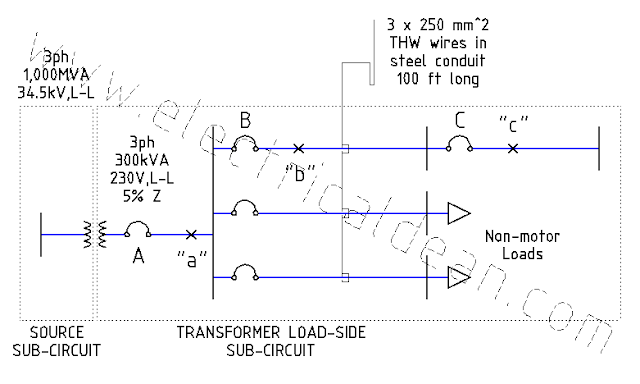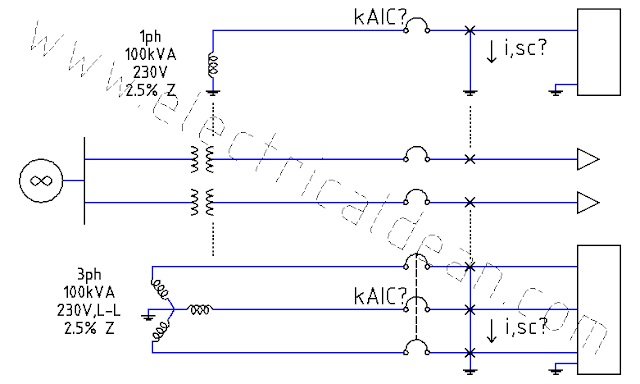Faults - Scenario 7
This post is almost identical to the previous scenario, except that there are no motors present in the adjacent circuits.
SITUATION
An industrial complex receives 230 V, 60 Hz from a bank of three single-phase distribution transformers interconnected into a three-phase configuration. Each distribution transformer is rated 100 kVA, and the entire bank has an impedance of 5%. The transformer bank taps into a 34.5 kV supply with a 1,000 MVA short-circuit capacity.
Using the per-unit method, what maximum symmetrical fault currents may occur in each of the fault points "a", "b", and "c"? From these fault currents, what are the minimum symmetrical kiloAmpere Interrupting Capacity (kAIC) ratings needed for each molded case circuit breaker (MCCB) A, B, and C?
ANALYSIS
1.) ESTABLISH COMMON BASE VALUES.
New base power, 3ph: S,base,new = 300 kVA
No need to establish a common base voltage. By retaining the existing base voltages, the per-unit supply voltage for each sub-circuit is pegged at 1 pu.
2.) CONVERT PER-UNIT VALUES FROM THE GIVEN BASE VALUE TO THE COMMON BASE VALUE.
2.1.) SOURCE SUB-CIRCUIT
Actual power, 3ph: S,src,3ph = 1,000 MVA
Actual voltage, LL: V,src,LL = 34.5 kV
Actual impedance, 1ph: Z,src,1ph = (V,src,LL)^2 / S,src,3ph
For the source sub-circuit, the actual values can be used as given base values.
Base power, 3ph: S,base = S,src,3ph
Base voltage, LL: V,base = V,src,LL
Base impedance, 1ph: Z,base = (V,base)^2 / S,base
2.1.1.) Source impedance, given, per-unit:
Z,src,pu = Z,src,1ph / Z,base
Z,src,pu = [ (V,src,LL)^2 / S,src,3ph ] / [ (V,base)^2 / S,base ]
Z,src,pu = [ (V,src,LL)^2 / S,src,3ph ] / [ (V,src,LL)^2 / S,src,3ph ]
Z,src,pu = 1 pu
2.1.2.) Source impedance, new, per-unit:
Z,src,new,pu = Z,src,1ph / Z,base,new
Z,src,new,pu = Z,src,pu * Z,base / Z,base,new
Z,src,new,pu = Z,src,pu * (V,base^2 / S,base) / (V,base^2 / S,base,new)
Z,src,new,pu = Z,src,pu * V,base^2 * S,base,new / (V,base^2 * S,base)
Z,src,new,pu = Z,src,pu * S,base,new / S,src,3ph
Z,src,new,pu = 1 * 300kVA / 1,000MVA
Z,src,new,pu = 0.0003 pu
2.2.) TRANSFORMER LOAD-SIDE SUB-CIRCUIT
Base power, 3ph: S,base = 300 kVA
Base voltage, LL: V,base = 230 V
Base impedance, 1ph: Z,base = (V,base)^2 / S,base
2.2.1.) Transformer impedance, given, per-unit: Z,xmr,pu = 5% = 0.05 pu
2.2.2.) Transformer impedance, new, per-unit:
Z,xmr,new,pu = Z,xmr,1ph / Z,base,new
Z,xmr,new,pu = Z,xmr,pu * Z,base / Z,base,new
Z,xmr,new,pu = Z,xmr,pu * (V,base^2 / S,base) / (V,base^2 / S,base,new)
Z,xmr,new,pu = Z,xmr,pu * V,base^2 * S,base,new / (V,base^2 * S,base)
Z,xmr,new,pu = Z,xmr,pu * S,base,new / S,base
Z,xmr,new,pu = 0.05pu * 300kVA / 300kVA
Z,xmr,new,pu = 0.05 pu
2.2.3.) Conductor impedance, 1L:
For the cable conductors in the load-side circuit, their specifications are 250 mm^2 THW in steel conduit at 100 ft long (30.4878 m).
According to 2017 PEC Table 10.1.1.9 [ or 2017 NEC Chapter 9 Table 9 ] AC Resistance and Reactance for 600 V Cables, the resistance and reactance for such specification are 0.029 ohms per 305 meters and 0.048 ohms per 305 meters, respectively. [ 305 meters ~= 1,000 feet ]
Z,wire,1L = [ (0.029 + j0.048) ohms / 305 m ] * 30.5 m
Z,wire,1L = (0.0029 + j0.0048) ohms
Z,wire,1L = 0.005608 ohms < 58.86 deg
2.2.4.) Conductor impedance, per-unit:
Z,wire,pu = Z,wire,1L / Z,base,new
Z,wire,pu = Z,wire,1L / (V,base^2 / S,base,new)
Z,wire,pu = 0.005608 ohms / (230V^2 / 300kVA)
Z,wire,pu = 0.0318 pu
3.) FAULT CALCULATIONS
3.1.) AT FAULT POINT "a"
3.1.1.) One-line diagram for circuit at fault point "a":
o|---V,pu---Z,a,pu---"a"---|> o|---V,pu---Z,src,new,pu---Z,xmr,new,pu---"a"---|>
3.1.2.) Short-circuit current at fault point "a", per-unit:
i,a,pu = V,pu / Z,a,pu
i,a,pu = V,pu / (Z,src,new,pu + Z,xmr,new,pu)
i,a,pu = 1 / (0.0003 + 0.05)
i,a,pu = 19.8807 pu
3.1.3.) Short-circuit current at fault point "a", 1L:
i,a,sc = i,a,pu * i,base,new
i,a,sc = i,a,pu * S,base,new / (sqrt(3) * V,base)
i,a,sc = 19.8807pu * 300kVA / (sqrt(3) * 230V)
i,a,sc = 14,971.4707 Amps
i,a,sc = 14.971 kiloAmps
3.1.4.) Minimum interrupting capacity of MCCB A:
3-phase molded case circuit breaker A >= 15 kAIC symmetrical
3.2.) AT FAULT POINT "b"
3.2.1.) One-line diagram for circuit at fault point "b":
o|---V,pu---Z,b,pu---"b"---|> o|---V,pu---|---Z,src,new,pu---Z,xmr,new,pu---|---"b"---|>
3.2.2.) Short-circuit current at fault point "b", per-unit:
i,b,pu = V,pu / Z,b,pu
Z,b,pu = (Z,src,new,pu + Z,xmr,new,pu)
Z,b,pu = 0.0003 + 0.05
Z,b,pu = 0.0503 pu
i,b,pu = 1 / 0.0503
i,b,pu = 19.8807 pu
3.2.3.) Short-circuit current at fault point "b", 1L:
i,b,sc = i,b,pu * i,base,new
i,b,sc = i,b,pu * S,base,new / (sqrt(3) * V,base)
i,b,sc = 19.8807pu * 300kVA / (sqrt(3) * 230V)
i,b,sc = 14,971.4707 Amps
i,b,sc = 14.971 kiloAmps
3.2.4.) Minimum interrupting capacity of MCCB B:
3-phase molded case circuit breaker B >= 15 kAIC symmetrical
3.3.) AT FAULT POINT "c"
3.3.1.) One-line diagram for circuit at fault point "c":
o|---V,pu---Z,c,pu---"c"---|> o|---V,pu---|---Z,src,new,pu---Z,xmr,new,pu---|---Z,wire,pu---"c"---|>
3.3.2.) Short-circuit current at fault point "c", per-unit:
i,c,pu = V,pu / Z,c,pu
Z,c,pu = (Z,src,new,pu + Z,xmr,new,pu) + Z,wire,pu
Z,c,pu = (0.0003 + 0.05) + 0.0318
Z,c,pu = 0.0503 + 0.0318
Z,c,pu = 0.0821 pu
i,c,pu = 1 / 0.0821
i,c,pu = 12.1803 pu
3.3.3.) Short-circuit current at fault point "c", 1L:
i,c,sc = i,c,pu * i,base,new
i,c,sc = i,c,pu * S,base,new / (sqrt(3) * V,base)
i,c,sc = 12.1803pu * 300kVA / (sqrt(3) * 230V)
i,c,sc = 9,172.5645 Amps
i,c,sc = 9.173 kiloAmps
3.3.4.) Minimum interrupting capacity of MCCB C:
3-phase molded case circuit breaker C >= 10 kAIC symmetrical (Ceiling value for breaker safety)
CONCLUSION
Without motors contributing to the fault currents, points "b" and "c" in this scenario experience slightly lesser fault magnitudes compared to the previous scenario having motors in adjacent circuits.
The maximum symmetrical fault currents are 14.971 kiloAmperes at point "a", 14.971 kiloAmperes at point "b", and 9.173 kiloAmperes at point "c".
The minimum symmetrical kiloAmpere Interrupting Capacity ratings needed then is 15 kAIC for 3ph MCCB A, 15 kAIC for 3ph MCCB B, and 10 kAIC for 3ph MCCB C.
==========
REFERENCES
1.) Philippine Electrical Code (SI Modernized Metric System)
1.1.) 2017 PEC Table 10.1.1.9 Alternating-Current Resistance and Reactance for 600-Volt Cables, 3-Phase, 60Hz, 75degC - Three Single Conductors in Conduit.
1.2.) 2017 PEC Appendix D Example D14 Simplified Fault Current Calculation.
2.) National Electrical Code (US Inch-Pound System)
2.1.) 2017 NEC Chapter 9 Table 9 Alternating-Current Resistance and Reactance for 600-Volt Cables, 3-Phase, 60Hz, 75degC (167degF) - Three Single Conductors in Conduit.
2.2.) [Not found in 2017 NEC Annex D] (Simplified Fault Current Calculation).





Comments
Post a Comment